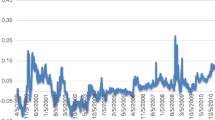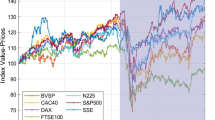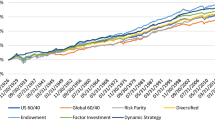Abstract
Researchers and practitioners have devoted considerable attention to devising market-timing strategies as potential value-enhancement tools. The success of such active or tactical asset allocation strategies is dependent on their ability to capture either inefficiencies, to the extent that they exist, or disequilibria associated with changes in the investor opportunity set. Much of the equity-style timing literature focuses on the shifting between pairs of risky assets or between one risky and one riskless asset class, using a binomial approach. This paper develops a multinomial timing model based on macroeconomic and fundamental public information using Frank Russell large-cap and small-cap style indexes. We model four different market segments simultaneously. Out-of-sample tests demonstrate that active multi-style rotation strategies can be devised that outperform the best performing buy-and-hold portfolio. The profitability of such strategies is robust to reasonable levels of transaction costs.

Similar content being viewed by others
Notes
Inception date of the Frank Russell Company style indexes.
ETFs provided by Barclay Global Fund Advisors: iShares Russell 1000 Value (IWD), iShares Russell 1000 Growth (IWF), iShares Russell 2000 Value (IWN), and iShares 2000 Growth (IWO).
See, for example, Ferson and Harvey (1994), Solnick (1993), Jensen, Mercer, and Johnson (1996), Chan, Karceski and Lakonishok (1998), Copeland and Copeland (1999), Kao and Shumaker (1999), Levis and Liodakis (1999), Kao and Shumaker (1999), Copeland and Copeland (1999), Avramov (2002), Black (2002), and Resnick and Shoesmith (2002).
All of the variables are in the information set of the investor at time t, for projecting the probabilities of t+1. Hence, there is no look ahead bias in the model.
This variable is the Conference Board announcement of the change in the consumer confidence index. It is the announced estimate for month t less the estimate of month t−1 as reported at month t. For the CPI, the variable used for time t is the announced level at month t, which actually corresponds to the level of the CPI at t−1, less that of the previous month.
The geometric mean difference between the long-term government bond and US 30-day T-bills returns.
The difference between the earnings to price ratio (E/P) of the S&P500 and the long-term government bond yield.
The geometric mean difference between long-term corporate and government bond returns.
We have also performed the analyses for various alternative definitions of bull and bear markets, including the bull (bear) market definitions suggested: that is, when the market excess return (S&P500 return less the one-month t-bill rate) is positive (negative), the market is characterised as a bull(bear) market; the extreme bull (bear) market definition is also used: a market is an extreme bull (bear) market when the market excess return is greater (less than) than the mean plus (minus) 0.5 standard deviations. Using these definitions, the default model performs very well relative to the S&P and the momentum strategies during the up and extreme up market periods; its performance is similar to the S&P, and considerably better than the momentum strategies during down market periods, and better than the S&P and the momentum strategies during extreme down markets: these results are available from the authors on request.
Approximately 2.4 times more.
In order to test whether logit probabilities are different across the asset classes, we estimated several models imposing probability cutoffs. Results show that default strategy does as well as other cutoff strategies. The results of this exercise are available from authors upon request.
As a further check of the performance of the style investment strategies, we also looked at the simple small cap vs large cap and the value vs growth dichotomies. Based on the Russell 1000 (2000) index as the benchmark large-cap (small-cap) portfolios, the terminal wealth on a $100 investment in January 1984 to December 2000 would have been $1253.99 ($579.76) corresponding to a monthly return of 1.022 per cent (0.86522 per cent). Using the Fama–French Value vs Growth benchmarks, we note that the terminal wealth on a $100 investment in the Fama–French Value (Growth) in January 1984 to December 2000 would have been $1,136.08 ($1,172.253) corresponding to a monthly return of 1.19838 per cent (1.21392 per cent). It is interesting to note that none of these style portfolios performs as well as the S&P500, let alone the default strategy.
First-year trading costs amount to 27 bps (25 bps for buying a 100 per cent of the index selected by our model and 2 bps for selling 4 per cent of the portfolio at the end of June).
Computed as : 0.08*50 bps=4 bps.
The full specification of the updated model is available on request. The elasticity estimates are fairly similar to those of the earlier specification for the common variables that appear, although in the more recent period, both consumer confidence changes and inflation changes (as captured by changes in the CPI) now have negative elasticities on the log odds of the large-cap value portfolios. Also, a positive effect of the lagged equity risk premium for the large-cap value portfolio is indicative of a mild momentum effect for the more recent period.
We also compared the default strategy (of choosing the asset class with the highest ex ante probability) with two momentum strategies, consistent with Jegadeesh and Titman, Carhart, and others. Momentum 1(2) is formed as the portfolio in which the investor invests 100 per cent in month t in the asset class that performed best in the previous year (month t−1); the default model has the investor place 100 per cent in the asset class with the highest ex ante probability each month; cut-35-Lg-Sg is the trading rule: if (Prob t+1>0.35) for one or more of the indices, then invest 100 per cent in the index with the highest conditional probability; or else if (Prob t+1⩽0.35), invest 50 per cent in both the Russell 1000 Growth index and the Russell 2000 Growth index.
References
Ahmed, P., Lockwood, L. and Nanda, S. (2002) ‘Multistyle Rotation Strategies’, Journal of Portfolio Management, 28, 17–29.
Amenc, N., El Bied, S. and Martellini, L . (2003) ‘Evidence of Predictability in Hedge Fund Returns and Multi-Style Multi-Class Style Allocation Decisions’, Financial Analysts Journal, 59, 32–46.
Arshanapalli, B., Coggin, T. D. and Doukas, J . (1998) ‘Multifactor Asset Pricing Analysis of International Value Investment Strategies’, Journal of Portfolio Management, 24, 10–23.
Arshanapalli, B., Switzer, L. N. and Hung, L. T. S . (2004) ‘Dynamic Asset Allocation for International Investment: Comparing Active versus Passive Strategies for EAFE and S&P 500’, Journal of Portfolio Management, 30, 51–60.
Avramov, D. (2002) ‘Stock Return Predictability and Model Uncertainty’, Journal of Financial Economics, 64, 423–458.
Barberis, N. and Shleifer, A. (2003) ‘Style Investing’, Journal of Financial Economics, 68, 161–199.
Bauman, W. S. and Miller, R. E. (1997) ‘Investment Expectations and The Performance of Value Stocks versus Growth Stocks’, Journal of Portfolio Management, 23 (3), 57–68.
Black, A. J. (2002) ‘The Impact of Monetary Policy on Value and Growth Stocks: An International Evaluation’, Journal of Asset Management, 3, 142–172.
Brinson, G. P., Randolph, H. and Beebower, G. L. (1986) ‘Determinants of Portfolio Performance’, Financial Analysts Journal, 42, 39–48.
Campbell, J. (1987) ‘Stock Returns and the Term Structure’, Journal of Financial Economics, 18, 373–399.
Campbell, J. and Shiller, R. (1988) ‘Stock Prices, Earnings, and Expected Dividends’, Journal of Finance, 1988, 661–676.
Chan, L. K. C., Karceski, J. and Lakonishok, J. (1998) ‘The Risk and Return from Factors’, Journal of Financial and Quantitative Analysis, 33 (2), 159–188.
Copeland, M. M. and Copeland, T. E. (1999) ‘Market Timing: Style and Size Rotation Using the VIX’, Financial Analysts Journal, 55, 73–81.
Fama, E. and French, K. (1989) ‘Business Conditions and Expected Returns on Stocks and Bonds’, Journal of Financial Economics, 25, 23–49.
Ferson, W. and Harvey, C. (1991) ‘Sources of Predictability in Portfolio Returns’, Financial Analysts Journal, 47, 49–56.
Ferson, W. and Harvey, C. (1994) ‘An Exploratory Investigation of the Fundamental Determinants of National Equity Returns’, in J. A. Frankel (ed.) The Internationalization of Equity Markets, University of Chicago Press, Chicago.
Greene, W. H. (2003) Econometric Analysis, 5th edn, Prentice Hall, Upper Saddle River, NJ.
Henriksson, R. D. and Merton, R. C. (1981) ‘On Market Timing and Investment Performance II: Statistical Procedures for Evaluating Forecasting Skills’, Journal of Business, 54, 513–533.
Ibbotson, R. G. and Kaplan, P. D. (2000) ‘Does Asset Allocation Policy Explain 40, 90, or 100 Percent of Performance?’ Financial Analysts Journal, 56, 26–33.
Jensen, G. R., Mercer, J. M. and Johnson, R. R. (1996) ‘Business Conditions, Monetary Policy, and Expected Security Returns’, Journal of Financial Economics, 40, 213–237.
Kao, D. L. and Shumaker, R. (1999) ‘Equity Style Timing’, Financial Analysts Journal, 55, 37–48.
Keim, D. and Stambaugh, R. (1986) ‘Predicting Returns in the Stock and Bond Markets’, Journal of Financial Economics, 17, 357–390.
Lakonishok, J., Shleifer, A. and Vishny, R. E. (1994) ‘Contrarian Investment, Extrapolation, and Risk’, Journal of Finance, 49, 1541–1578.
Leung, M., Daouk, H. and Chen, A. S. (2000) ‘Forecasting Stock Indices: A Comparison of Classification and Level Estimation Models’, International Journal of Forecasting, 16, 173–190.
Levis, M. and Liodakis, M. (1999) ‘The Profitability of Style Rotation Strategies in the United Kingdom’, Journal of Portfolio Management, 26, 73–86.
Oertmann, P. (1999) ‘Why Do Value Stocks Earn Higher Returns Than Growth Stocks, and Vice-Versa?’, Working Paper, Investment Consulting Group Inc. and University of St. Gallen.
Park, K. and Switzer, L. N. (1996) ‘Mean Reversion of Interest-Rate Term Premiums and Profits from Trading Strategies with Treasury Futures Spread’, Journal of Futures Markets, 16, 331–352.
Resnick, B. G. and Shoesmith, G. L. (2002) ‘Using the Yield Curve to Time the Stock Market’, Financial Analysts Journal, 58, 82–90.
Sharpe, W. F. (1992) ‘Asset Allocation: Management Style and Performance Measurement’, Journal of Portfolio Management, 18, 7–19.
Solnick, B. (1993) ‘The Performance of International Asset Allocation Using Conditioning Information’, Journal of Empirical Finance, 1, 33–55.
Acknowledgements
Financial support from the SSHRC (Grant # 410-2001-0613) to Switzer is gratefully acknowledged.
Author information
Authors and Affiliations
Corresponding author
Rights and permissions
About this article
Cite this article
Arshanapalli, B., Switzer, L. & Panju, K. Equity-style timing: A multi-style rotation model for the Russell large-cap and small-cap growth and value style indexes. J Asset Manag 8, 9–23 (2007). https://doi.org/10.1057/palgrave.jam.2250056
Received:
Published:
Issue Date:
DOI: https://doi.org/10.1057/palgrave.jam.2250056




